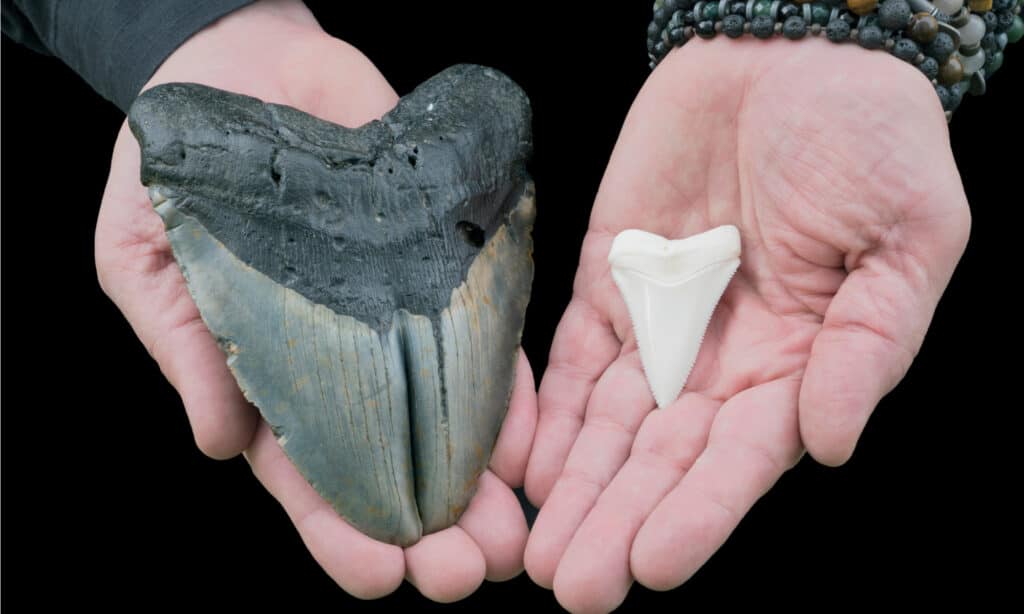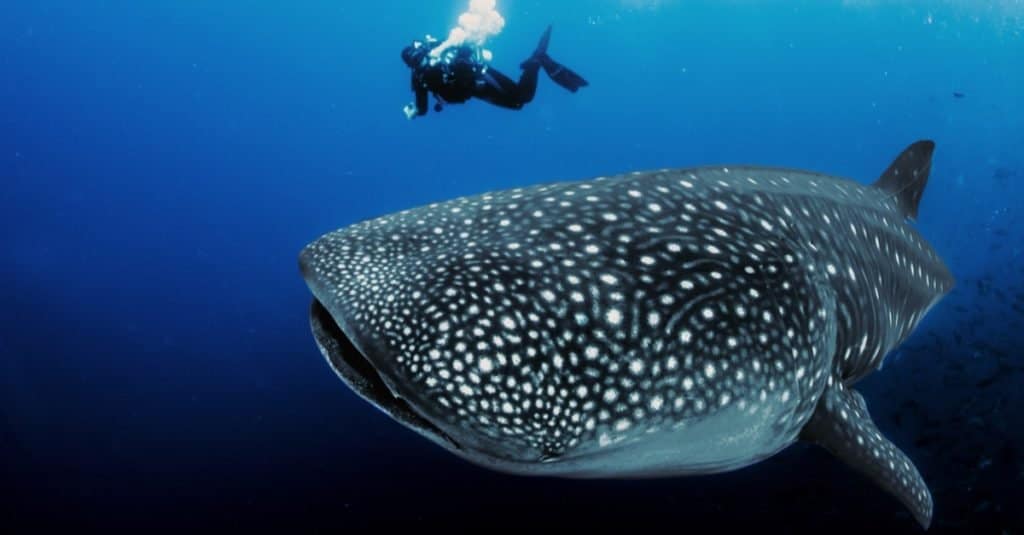Shark teeth are common findings on beaches and similar areas. Some species shed about 35,000 teeth in their lifetime. This is because sharks shed their teeth constantly. Those that fall out are replaced, so this fierce predator can continue hunting.
The same applies to shark tooth fossils. Certain areas worldwide, such as Bawdsey Beach, are popular attractions for fossil hunting. In fact, a 3.9-inch (10 cm) fossilized shark tooth was recently found by a six-year-old boy on the mentioned beach.
Given the prevalence of shark teeth, it goes without saying that people are looking for large ones. After all, the price of a shark tooth fossil is influenced directly by its size. In the following lines, you’ll discover more about the largest shark tooth ever discovered – 7.48 inches (18.9 cm)!
What is the biggest shark ever recorded?

The biggest shark ever recorded in the history of humankind is the megalodon.
©racksuz/Shutterstock.com
The biggest shark ever recorded in the history of humankind is the megalodon. This species, Otodus megalodon (binomial name), was the largest fish to ever exist and the biggest shark in the world. It lived between 23 and 3.6 million years ago.
The megalodon is a close relative of the great white shark, another species known for its impressive size (females can grow up to 20 feet (6.1m) long).
Scientific estimates suggest that the maximum length of a megalodon would be up to 66 feet (20 m). A megalodon this long would weigh about 227,076 lbs (103 metric tons).
It is worth mentioning that all megalodon fossils discovered are classified as fragmentary. In short, only vertebrae and teeth have been found so far. Size and weight estimates are based solely on these, so those might be slightly inaccurate. For example, some scientists suggest that the largest specimens would grow as long as 82 feet (25 m).
How many teeth do megalodons have?
The megalodon preyed on whales. When hunting whales, megalodons relied mainly on their incredibly wide jaws. While open, the jaw of a megalodon would be about 8.8 feet (2.7 m) by 11.1 feet (3.4 m) wide. The animal’s length, on its own, wouldn’t be of much help in this type of encounter.
Whale skin is about 2 to 8 inches (5-20 cm) thick. Wide jaws aren’t enough. Luckily enough for the megalodon, its mouth was equipped with as many as 276 teeth. This number contributed to one of the most powerful bite forces in the history of predatory animals. Estimates suggest that a Megalodon bite had a force of up to 40,960 lbs (182,201 N). One of today’s fiercest predators, the white shark, has a bite force of only 4,095 lbs (18,216 N).
It goes without saying that tooth size also played a big role, especially when it came to penetrating 8-inch thick prehistoric whale skin!
How big was a megalodon tooth?

Megalodon teeth measured, on average, 7.1 inches.
©Mark_Kostich/Shutterstock.com
Megalodon teeth measured, on average, 7.1 inches (18 cm). The teeth of this species are the largest of any known species of shark worldwide. An impressive aspect of the megalodon’s mouth and teeth was that it had five rows of teeth.
These five rows featured four different kinds of teeth – posterior, lateral, anterior, and intermediate. Even though they were different, the average length of a tooth was still the one mentioned above.
The size of a megalodon tooth tells us that the species specialized in feeding on large prey, such as the aforementioned whales. Besides whales, Megalodons would also hunt dolphins and other sharks.
What is the biggest tooth ever?
The biggest tooth ever is actually a tusk, and it belongs to the prehistoric mastodon. As found fossils suggest, a single mastodon tusk could grow as long as 165.3 inches (420 cm).
Even though not an actual tooth, mastodons used their tusks to defend themselves or even hunt, as suggested by a mysterious mastodon species. This is why comparing megalodon teeth with mastodon tusks is worthwhile!
What is the largest shark tooth ever found?
The largest shark tooth ever discovered has a slant height of 7.48 inches (18.9 cm) and belongs to a megalodon. It was found fragmented in the Ocucaje desert of Peru by Craig Sundell. After being discovered, the tooth was glued and measured.
The second-largest shark teeth ever discovered were found by Vito Bertucci and Pete Larson. Vito Bertucci found his in South Carolina and Pete Larson in Peru. Both specimens measure 7.24 inches (18.4 cm) in length. Some suggest that Larson’s specimen was artificially elongated during the reconstruction process (as it was found broken).
For comparison, the largest shark tooth ever found – 7.48 inches (18.9 cm) – is about half the size of a bowling pin or as long as a dinner fork. However, take into account that this refers to slant size – from the tip of the tooth, diagonally to the base of its root.
How big are whale shark teeth?

Whale sharks are equipped with sets of teeth of about 2.5 to 3 inches.
©Lindsey Lu/Shutterstock.com
A whale shark can grow up to 55.7 feet (16.9 m) in length, making it the biggest live shark in the world. It is only about 10 feet (3 m) smaller than the largest estimated megalodons. Let’s now compare their teeth and see how whale sharks fare compared to their ancestors.
Whale shark teeth vary greatly in size. They can be as short as 0.2 inches (0.5 cm). In fact, a whale shark can have up to 3,000 of these tiny teeth in its mouth! However, the shark’s teeth for eating can grow up to 7 inches (17.7 cm).
On average, whale sharks are equipped with sets of teeth of about 2.5 to 3 inches (6.3 to 7.6 cm). Specimens with 5 to 7 inches (12.7 – 17.7 cm) teeth exist, but they are quite rare.
Whale shark teeth became smaller in time because the animal developed filter feeding. Instead of relying on their mouths and teeth, they simply filter small plankton from the water, making it their primary diet.
The photo featured at the top of this post is © Mark_Kostich/Shutterstock.com
Thank you for reading! Have some feedback for us? Contact the AZ Animals editorial team.






